
Travel Guide
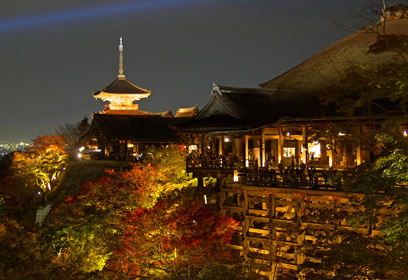
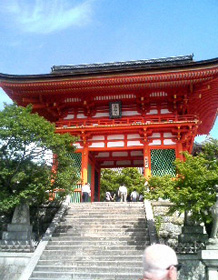
Introduction
Kiyomizudera Temple (literally "Pure Water Temple"), officially Otowa-san Kiyomizudera Temple, is oldest temple and is an independent Buddhist temple in Kyoto. Kiyomizudera Temple is the 16th of the Western Japan 33 Kan'non pilgrimage sites. In 1994, the temple was added to the list of UNESCO world heritage sites. In 2007, Kiyomizudera Temple was one of 21 finalists for the New Seven Wonders of the World. However, it was not picked as one of the seven winning sites. Kiyomizudera Temple takes its name from the waterfall within the complex, which runs off the nearby hills. Kiyomizu means clear water, or pure water.
Kiyomizudera Temple is best known for its wooden stage that juts out from its main hall (hondo), 13 meters above the hillside below. The stage affords visitors a nice view of the numerous cherry and maple trees below that erupt in a sea of color in spring and fall, as well as of the city of Kyoto in the distance. The main hall, which together with the stage was built without the use of nails, houses the temple's primary object of worship, a small statue of the eleven faced, thousand armed Kan'non (Juichimen-Senju-Kan'non). The Kan'non is shown to the public once in 33 years and other special events only and no photos are available to the public.
History
Kiyomizudera Temple was founded in the early Heian period and the temple was founded in 798. Since its foundation, the temple has burned down many times. During the Togukawa shogunate major restorations of the architecture and artwork were sponsored by the rulers, especially during the rule of the third Shogun, Tokugawa Iemitsu. Most of the current buildings were rebuilt in 1633, ordered by the third Shogun Tokugawa Iemitsu in the early Edo period (1631 to 1633).
This temple used to be a Hosso-shu sect temple but became independent in 1965 and call themselves the headquarters of Kita-Hosso-shu (North Hosso-shu) sect.
Present
The main hall of the temple is designated as a national treasure. The temple has many other important cultural properties including the Deva gate, west gate, three-storied pagoda and bell tower.
The popular expression "to jump off the stage at Kiyomizu" is the Japanese equivalent of the English expression "to take the plunge". This refers to an Edo period tradition that held that, if one were to survive a 13m jump from the stage, one's wish would be granted. Two hundred thirty-four jumps were recorded in the Edo period and, of those, 85.4% survived. The practice is now prohibited.
Beneath the main hall is the Otowa Waterfalls, where three channels of water fall into a pond. Visitors can catch and drink the water, which is believed to have wish-granting powers. Each channel’s water is said to have a different benefit, namely to cause longevity, success at school and a fortunate love life. However, drinking from all three streams is considered greedy.
The temple complex includes several other shrines, among them the Jishu Shrine, dedicated to Okuninushi, a god of love and "good matches". Jishu Shrine stands behind Kiyomizudera Temple's main hall. In front of the shrine are two "love stones" placed 18 meters apart, which lonely visitors can try to walk between with their eyes closed. Success in reaching the other stone with their eyes closed implies that the pilgrim will find love, or true love. One can be assisted in the crossing, but this is taken to mean that a go-between will be needed. The person's romantic interest can assist them as well.
To the right of Otowa Waterfalls are three small halls: Shaka-do, Amida-do and Okuno-in. The Shakado was rebuilt after it collapsed in a mudslide in 1972. The Amida-do has an image of the Amida Nyorai, the Buddha of the Western Paradise and it is said that the priest Honen in 1188 proclaimed his doctrine of nenbutsu or praise to the Amida Buddha, thus beginning the Jodo sect of Japanese Buddhism. The Okuno-in, which resembles the main hall on a smaller scale and has also a stage, is a thatched structure said to be the spot where Enchin encountered the legendary hermit Gyo-ei, an event which lead to the founding of the temple.
Around the entrance of Kiyomizudera Temple, outside the paid area, stand various other temple buildings, including a vermilion three storied pagoda, a repository for sutras, large entrance gates and the Zuigudo Hall which is dedicated to Buddha's mother and where against a small entrance fee you can wander the pitch black basement that symbolizes a mother's womb.
The complex also offers various talismans, incense, and omikuji (paper fortunes). The site is particularly popular during festivals (especially at New Year's and during obon in the summer) when additional booths fill the grounds selling traditional holiday foodstuffs and souvenirs to throngs of visitors.
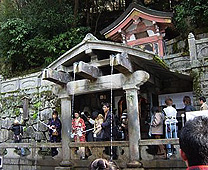 |
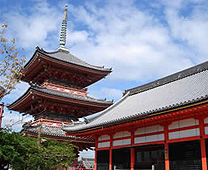 |
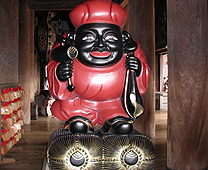 |
| Otowa Waterfalls | Sanju-no-To and Kyo-do | Daikokuten |
Travel Advice
Sightseeing
- The quaint street leading up to the temple is named Sannen-zaka. It is a small shopping street lined with souvenir shops, restaurants and ryokan (Japanese-style inns). You can follow this street as it winds its way down past Nene no Michi, Kodaiji Temple to Gion - the traditional pleasure and geisha quarter of the city. On the way is Yasaka Gojo-no-to, a five-story pagoda.
- Kiyomizudera Temple is always full with visitors because its popularity. You can visit the temple around 7 in the morning to avoid the crowd.
- There's a small place called Tainai-meguri. It is on the left side of the stairway leading up to the temple. Tainai literally means womb. Going through the cave is like returning to the womb of a female Bodhisattva and feel like being reborn. When you get to the rock which is placed at the end of the cave, spin it in either direction to make a wish. It is said that the female Bodhisattva is with the ability to grant wishes. There is no light in the cave but you can keep your hand on the roped handrail. If you are not afraid of the dark, the experience will be calming and sublime. The open hours of Tainai-meguri is 9:00 to 16:00. Tickets are required for entering Tainai-meguri.
- Just underneath the main hall is the famous Otowa Waterfalls where three channels of waterways fall together in one pond. Visitors of the Kiyomizudera Temple can drink these waters which are believed to possess some miraculous therapeutic powers. These waters are also said to be powerful enough to bring longevity, health, and wisdom to whoever drinks it. However, an ancient belief of the Japanese tells that it is morally right to choose only two of these options because people who are greedy enough to take three of the offered gifts will only cast misfortune upon themselves.
- The sunset and night view of the Kiyomizudera Temple is also worth seeing. Lit up buildings such as Sanju-no-to and the main gate are picturesque. The sunset view of the Kyoto city from the veranda of main hall is recommended.
The legend of Kiyomizudera Temple
Kiyomizudera Temple is an old temple of the Hosso sect of Buddhism, a relatively small sect that was established--according to legend--in 657 by the monk Dosho from China. It is said that Kiyomizudera Temple was founded in 798 by the monk Enchin through the patronage of the warrior Tamuramaro. Legend states that Enchin dreamt of a golden stream flowing down from this mountain into the Yodogawa River. When he went to investigate, he found an old man sitting on a log who gave his name as Gyoei. The old man told Enchin that he had spent the last 200 years reciting invocations to Kan'non (a god with eleven faces and 1,000 arms). He wished Enchin to take his place so that he could make a pilgrimage, promising the young man that the log he'd been sitting on would make good material for an image of Kan'non. Enchin waited for a long time but the man did not return. Hoping to find the old man, Enchin ascended a nearby hill and discovered a pair of shoes lying on the summit. Enchin suddenly realized that the old man had been none other than Kan'non himself--the shoes left behind signaled that the "old man" had returned to heaven. He hurried back to the log, determined to make it into an image of Kan'non as the god himself had suggested.
Twenty years passed, but Enchin could still not figure out how to shape the log into a proper image. Finally one day the warrior Saka-no-ue Tamuramaro came through the forest hunting a stag for his pregnant wife (it was believed that stag's blood eased childbirth). Tamuramaro came upon Enchin in the woods. Impressed with his devotion, he decided that he would dismantle his own house and reassemble it as a temple beside a nearby waterfall. With Tamuramaro's backing, Enchin finished the image and took residence in the new temple.
Legend also says that after Tamuramaro's gift, the warrior took part in expeditions against the indigeonous inhabitants of northern Japan. The Emperor rewarded him with the title "Barbarian-subduing Generalissimo" for his deeds and gave him a fine building at the site of Nagaoka palace. Tamuramaro also donated this building to the temple.
There is no way to test the veracity of the early legends concerning Kiyomizudera Temple, for the original temple burned a number of times over the centuries. In one notable conflict--the 15th century Onin War--it actually escaped damage because it remained neutral in the great sectarian feuds that ravaged the city (the Hosso sect was perhaps too small to get involved).
Visit
| Address | 1-294 Kiyomizu, Higashiyama-ku, Kyoto-shi, Kyoto | |
| Phone | 075-551-1234 | |
| Admission | Free | Tickets required for facilities |
| Hours | 06:00 to 18:00 Jan 1to Mar 26 06:00 to 21:30 Mar 27 to Apr 5 Special Night 06:00 to 18:00 Apr 6 to Jun 30 06:00 to 18:30 Jul 1 to Aug 13 06:00 to 21:30 Aug 14 to Aug 16 Special Night 06:00 to 18:30 Aug 17 to Aut 31 06:00 to 18:00 Sep 1 to Nov 17 06:00 to 21:30 Nov 18 to Nov 30 Special Night 18:30 to 18:00 Dec 1 to Dec 31 |
Entry until 30 minutes before closing |
| Closed | Open 7 Days a Week | |
| Duration | 40 minutes | |
| Getting There | By Train Take City Bus No.206 bound for Kita'oji Bus Terminal from JR Kyoto Station to the Gojo-zaka bus stop, then walk approximately 10 minute. Take City Bus No.100 bound for Kiyomizudera Temple and Ginkakuji Temple from JR Kyoto Station to the Gojo-zaka bus stop, then walk approximately 10 minute. Take Kyoto Bus No.18 bound for Ohara from JR Kyoto Station to the Higashiyama-gojo bus stop, then walk approximately 10 minute. Kyoto Bus only runs at weekend and national holiday. Take City Bus No.207 bound for Tofukuji or Kujo Shako (Kujo Depot) from Gion-shijo Station on Keihan Electric Railway Keihan Honsen or Kawahara-cho on Hankyu Railway Kyoto Honsen to the Kiyomizu-michi bus stop, then walk approximately 10 minute. Take Keihan Bus No.83, 85, 87 or 88 from Gion-shijo Station on Keihan Electric Railway Keihan Honsen or Kawahara-cho on Hankyu Railway Kyoto Honsen to the Kiyomizu-michi or Gojo-zaka bus stop, then walk approximately 10 minute. 25 minute walk from Kiyomizu-gojo Station on Keihan Electric Railway Keihan Honsen. Take City Bus No.206 bound for Kita'oji Bus Terminal or City Bus No.100 bound for Kiyomizudera Temple and Ginkakuji Temple from Shichijo on Keihan Electric Railway Keihan Honsen to Gojo-zaka bus stop, then walk approximately 10 minute. By Car Take Meishin Expressway to the Kyoto-higashi exit. It is approximately 8 kilometers 20 minutes from exit. |
|
| Parking | No parking available | |

